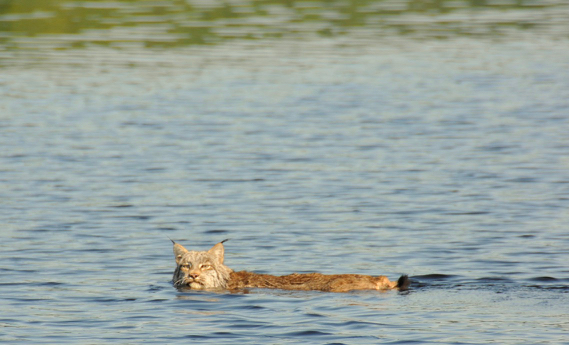Canada Lynx Doing Well on the Allagash
 Northern Maine’s resident wildcat- the Canada Lynx, is doing quite well along the shores of the Allagash Wilderness Waterway. In fact, so well, that the U.S. Fish and Wildlife Service which currently lists the lynx as threatened, has started the process of delisting the lynx from the endangered species list.
Northern Maine’s resident wildcat- the Canada Lynx, is doing quite well along the shores of the Allagash Wilderness Waterway. In fact, so well, that the U.S. Fish and Wildlife Service which currently lists the lynx as threatened, has started the process of delisting the lynx from the endangered species list.
While the delisting recommendation does not remove or negate the Endangered Species Act protections currently in place for the Canada Lynx, the decision does trigger a process to end them. The first step would be for U.S. Fish and Wildlife to publish a proposed rule in the Federal Register, then take public comments and finally draft a final decision.
In the lower 48- states, only Maine, Minnesota, Montana, Colorado, Idaho and Washington support resident breeding populations of lynx. Recently, lynx have been observed in New Hampshire and Vermont (including lynx with Kittens), suggesting lynx are expanding into former parts of their historic range.
Maine has the largest population of lynx in the lower 48- states and the population is growing. Chandler Woodcock, Commissioner of the Maine Department of Inland Fisheries and Wildlife, said in a statement provided by the Denver office of U.S. Fish and Wildlife. “Not only are lynx found in more places, but signs of lynx are found more frequently during our surveys.” Current estimates suggest between 750 and 1,000 adult lynx occupy the spruce/fir forests of northern and western Maine. Maine IF&W designates the Canada Lynx as a species of special concern.
The elusive wildcats are similar in size and appearance to bobcats. Lynx appear larger because of their long legs. The most distinguishing lynx characteristic, their unusually large feet, help them travel over deep snow, much like a cat on snowshoes. Lynx also have long ear tuffs and a completely black tipped tail, where bobcats have short ear tuffs and the tip of their tail is black on top and white underneath. Adult male lynx weigh between 26 – 30 pounds and females between 17- 20 pounds.
Male lynx are solitary for most of the year, except the breeding season. In March, they increase their movements in search of mates. Females give birth to litters of 1-5 kittens in dens usually consisting of a depression in a spruce/fir thicket, under a blowdown. Kittens are raised by the female, who occasionally leaves the den to hunt. Kittens are able to travel with their mother by early July, and stay with her until the following spring.
The size of a lynx home range can vary with snowshoe hare density, habitat, conditions, and season. In Maine, male home ranges are twice as large as a female’s home range, about half a township (18 square miles). Female lynx share their entire range with male and the male may share portions of his range with 1-3 adult females.
The forest-dwelling cat is a highly-specialized hunter. Snowshoe hare comprise over 75% of their diet. Lynx consume one or two hares a day. In summer, the diet is more varied and may include grouse, small mammals, and squirrels.
A lynx sighting can be the highlight of an Allagash canoe trip. These sightings are not uncommon in the Umsaskis and Long Lake section of the waterway. Steve Day, waterway ranger stationed at Umsaskis, regularly sends me pictures of lynx he sees while working in that area. A couple years ago, Steve got some great footage of a lynx swimming across the north end of Long Lake and on another occasion, one of the big cats walking across the bridge on the Realty Road.
Most of the lynx I have seen have been while traveling the many miles of gravel roads adjacent to the waterway. Most of my sightings have been just a fleeting glimpse of a long-legged animal jumping out of the road, but last winter, one just stood on the side of the road and let me have a good look at him. He was a fine-looking specimen, well furred, with tall ear tuffs and huge feet, he was a beauty!
March is a great time to get out and enjoy the last of what winter has to offer on the waterway. If you have never been to the waterway and need some help planning your trip, give me a call at (207)-695-3721 x3.
For ice conditions, or general information on the Allagash Wilderness Waterway, go to: www.maine.gov/allagash for an information packet call 207-941-4014, or write to the Department of Agriculture Conservation and Forestry’s Bureau of Parks and Lands, 106 Hogan Road, Bangor, ME 04401.
Matthew LaRoche is Superintendent of the Allagash Wilderness Waterway.
